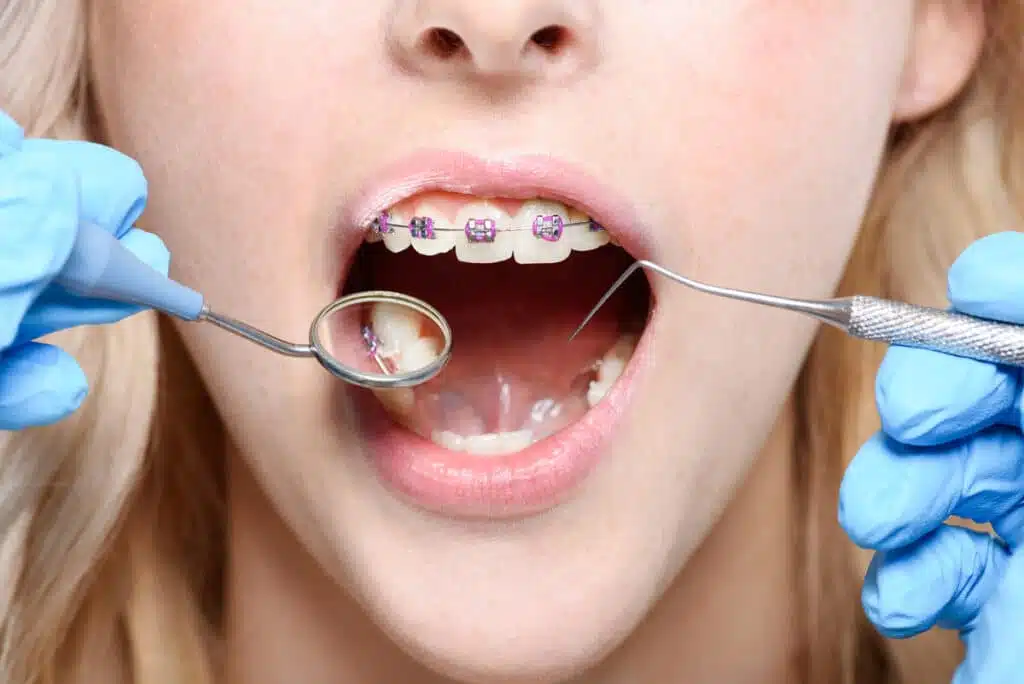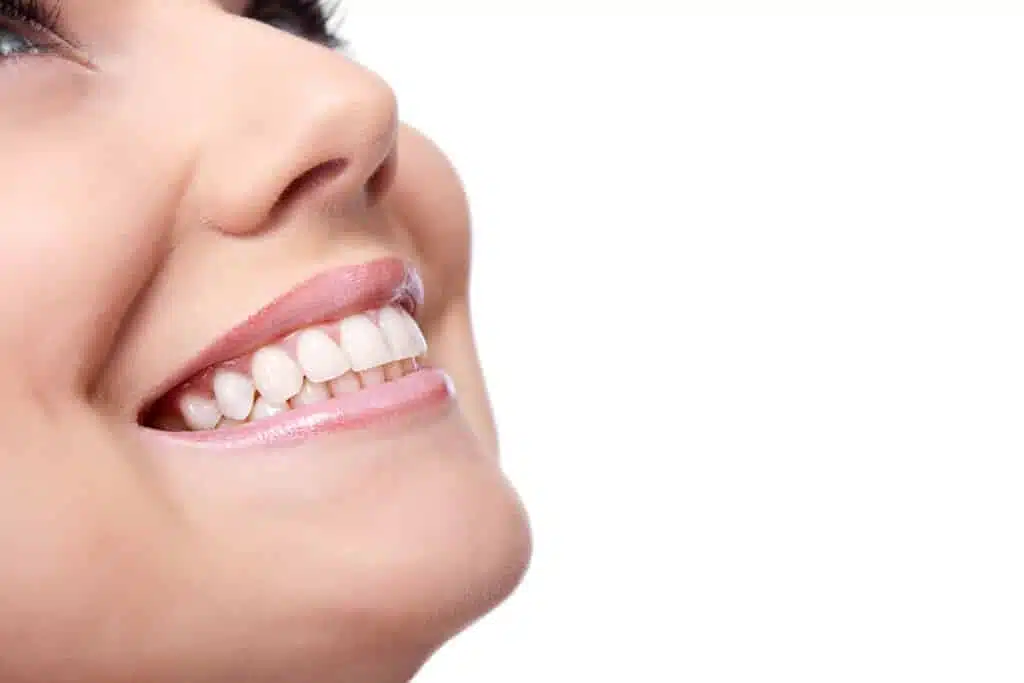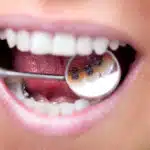Do braces cause pain? Here you can find all the information about the topic, the causes and methods of pain relief.
Braces are orthodontic appliances used to correct misaligned teeth and create a beautiful smile.
Many people, especially children and teenagers, need braces to straighten their teeth and achieve an optimal bite pattern.
Before someone decides to have their teeth straightened, it is important to know if braces cause pain and how to deal with it.
| Get 150 € discount on your dental correction! |

Book a consultation appointment now at a nearby DrSmile partner practice and find out if teeth straightening with aligners is right for you.
The appointment is completely non-binding and does not involve any costs.
With the code “THATSMILE150” you will receive 150 € discount on the treatment.
What exactly is a brace?
A brace consists of various components such as brackets, archwires and elastics.
Brackets are bonded to the teeth and the archwire is passed through the brackets to apply the required pressure.
The braces gradually apply pressure to the teeth to bring them into the desired position.
Why do you need braces?
Braces are needed to correct various malocclusions, such as crowding, gaps between teeth, overbite or underbite.
By correcting these misalignments, braces can not only improve the appearance of the smile, but also optimize jaw function and prevent long-term oral health problems.

What are the different types of braces?
There are different types of braces used by orthodontists. The two main categories are fixed braces and removable braces.
1. fixed braces
Fixed braces consist of brackets that are glued to the teeth and archwires that connect the brackets together.
They provide continuous pressure and areusually more effective in correcting complex tooth misalignments.
2. removable braces
Removable braces are often used as an alternative treatment option for less severe malocclusions.
They can be removed when you eat or brush your teeth.
Removable braces may require a longer treatment period and consistent wear to achieve the desired results.
3. invisible braces (aligners)
Invisible braces consist of transparent, custom-made splints that are placed over the teeth.
They are almost invisible and can be easily removed for eating and brushing teeth.
Since providers such as DrSmile use advanced technology, the cost of the invisible braces is usually lower than that of traditional braces.
How do braces work?
The way braces work depends on the type of brace.
1. fixed braces
Fixed braces work by applying pressure to the teeth and gradually moving them into the desired position.
The orthodontist regularly adjusts the archwire to increase pressure on the teeth and support movement.
2. removable braces
Removable braces work similarly to fixed braces, but they can be removed by the patient. However, they must be worn consistently to be effective.
| Get 150 € discount on your dental correction! |

Book a consultation appointment now at a nearby DrSmile partner practice and find out if teeth straightening with aligners is right for you.
The appointment is completely non-binding and does not involve any costs.
With the code “THATSMILE150” you will receive 150 € discount on the treatment.
Do braces cause pain?
Yes, it is normal for braces to cause some pain and discomfort, especially in the first few days after insertion or fitting.
Pain can vary in severity and can vary from person to person.
Pain after insertion
After braces are placed, teeth may be sensitive and pain may occur.
This is because the teeth have to adapt to the new force and the brackets.
Pressure and discomfort
The braces exert constant pressure on the teeth to move them.
This pressure can lead to a general discomfort that may be perceived as tenderness.
Sores and frictions
The metal components of braces can cause friction and lead to sores in the oral cavity.
This can cause pain, especially if the tongue or cheeks come into contact with it.
Fitting pain
When braces are adjusted to increase pressure, temporary pain may occur.
The teeth must once again adapt to the increased force.
Pain after fitting
After fitting, it may take a few days for the teeth to become accustomed to the increased force.
Pain may occur during this time, but should gradually subside.

Braces pain: tips for pain relief
There are several ways to relieve the pain associated with braces:
- Painkillers: For severe pain, over-the-counter painkillers such as ibuprofen or acetaminophen may be helpful.
- Use wax: Applying special wax to the brackets and wires can reduce friction and protect wound sites.
- Eat soft foods: During the first few days after braces are placed or adjusted, soft foods such as soups, yogurt or porridge can reduce discomfort.
- Cooling: Cooling the cheeks with an ice pack or cold cloth can relieve pain and swelling.
- Use mouth rinses: Mouthwashes with disinfectant or soothing properties can help heal sores and relieve pain.
How long does the brace pain last?
The duration of pain associated with braces can vary from person to person.
Usually, the pain subsides within a few days to a week as the teeth get used to the force and the braces.
When should you see the dentist?
It is important to keep regular appointments with the orthodontist to have braces treatment monitored.
However, if the pain is unbearable or lasts longer than a week, you should visit the dentist to rule out possible complications.

Pain associated with braces treatment
During braces treatment, certain events or adjustments may cause temporary pain. Here are some of them:
1. sheet change
When the orthodontist changes the arch of the braces, this may cause temporary pain as the teeth have to adjust to the new force.
2. activation of rubber bands
If elastics are hooked into the braces or activated, this can cause pain.
The elastics apply additional pressure on the teeth to achieve specific movements.
3. braces lifting
Sometimes braces are tightened to increase pressure on the teeth and speed up movement. This may cause temporary pain.
Conclusion on the subject of braces pain
Braces can cause temporary pain and discomfort as the teeth are gradually moved into the correct position.
It is important to understand that this pain is normal and should subside over time.
With proper pain relief techniques and consistent treatment, the braces experience can become much more comfortable.
However, in case of persistent or unbearable pain, the dentist should always be consulted to rule out possible problems.
| Get 150 € discount on your dental correction! |

Book a consultation appointment now at a nearby DrSmile partner practice and find out if teeth straightening with aligners is right for you.
The appointment is completely non-binding and does not involve any costs.
With the code “THATSMILE150” you will receive 150 € discount on the treatment.
FAQs about braces pain
At this point we answer some frequently asked questions about the topic “braces pain”.
How long does the pain last after braces are placed?
The pain after braces insertion can last for about 2-3 days. After that, they should gradually subside as the teeth get used to the new strength.
Is it normal for teeth to hurt after braces are fitted?
The pain after braces insertion can last for about 2-3 days. After that, they should gradually subside as the teeth get used to the new strength.
How to relieve the pain of braces?
The pain of braces can be relieved by using pain relievers, wax, soft foods, cooling, and mouth rinses.
What foods should be avoided to prevent pain?
It is advisable to avoid hard, sticky or crunchy foods as they can put additional pressure on the teeth and braces.
Are braces painful for everyone?
Pain sensitivity may vary from person to person. Not everyone experiences severe pain associated with braces, but some discomfort can occur.
How long does it take for teeth to get used to fixed braces?
Adjustment to fixed braces can take from a few days to several weeks, as the teeth need to get used to the constant pressure.
Can braces be worn during sports?
In most cases, braces should be worn during sports. However, it is advisable to wear a mouthguard during high-contact sports to protect the teeth and braces from injury.
Can braces wax alleviate other problems?
Yes, braces wax can also help with other problems like cheek biting or sharp edges of braces.
Are all braces made of metal?
No, there are also braces made of ceramic or plastic, which are less noticeable.
How often should I have braces readjusted?
The frequency of readjustment depends on the individual treatment planning. As a rule, braces are readjusted every 4-8 weeks.



Leave a Reply